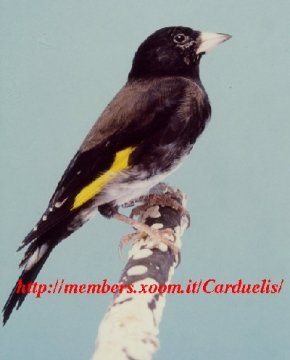|
|||||
|
|||||
|
MELANIC EUROPEAN GOLDFINCHES Simple aberration or mutation? | |||||
|
The two surviving subjects have been normally raised by parents and have happily
caught up their independence without any problems.
The melanism, already realized at the birth time, has made clear one week later, when the first black feathers began to grow, in particular, on the head of both babies and on the breast of one, the male (see photography 2 and 3). The next molt has emphasized the intesity of the black pigment, which (as documented by the photographies) is present in the most part of plumage, in particular in the plumage of male, in fact, at the end of molt, they have shown their gender characteristics: a male and a female. The subject of male gender is mainly black, the head, the chest are nearly completely black, the wings are black with a yellow band and a white-grayish pearling, the ancestral red mask and white color of the head have been replaced, almost completely, by black, traces of red are present and localized under the eyes and in both sides over the chin, the back is of a very dark brown color, as same as the both sides of the breast and the axillary zone, the rump is black, the tail is black with whitish cover-feathers, the abdomen is white with greyish soffusions, the beak is flesh-colored with the tip black, the claws are flesh-colored and dark patinated. The subject of feminine gender displayes the black less concentrated and less disseminated then her brother, the head is completely black, the back and the chest are of a tawny dark color, the wings are black with a yellow band and a white-grayish pearling, the ancestral red mask has been replaced, almost completely, by black, traces of red are present and localized under the eyes and in the lateral sides over the chin, other soffusions of white-grayish color remain on the cheeks and on the nape of the neck. The back, the chest and the flanks are tawny dark, the rump is tawny-grayish, the tail is black with whitish cover-feathers, the abdomen is whitish, the beak is flesh-colored with the tip black, the claws are flesh-colored and dark patinated.
|

Photo 3 - Melanic Europen Goldfinch Male
As the specificity of the above description:
In both cases a further investigation becomes extremely interesting and exciting. To the aim to deepen the issue, I have consulted a lot of books and I have had the confirmation that the greater part of the literature in matter describes the melanism as an aberration not hereditary related to endocrine troubles or metabolic troubles (nourishment problems
|
||||
|
|||||
|
Copyright © 1999 by Angelo Fumagalli - All rights reserved.
No part of information and images, contained in this article may be used,
copied, photocopied, reproduced, translate in whichever other language or
format, supplied or however made available to other persons without the
written consent of the Author.
| |||||





